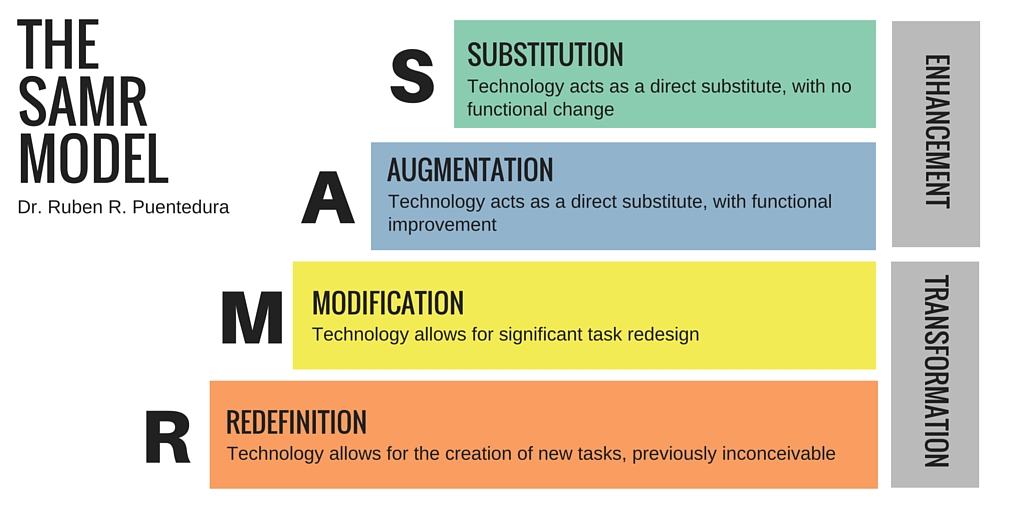 |
| Image from: Wikimedia Commons |
Let's Think About What We're Doing: The SAMR Model
@LisaBerghoff/@MrKimDHS
When I first embarked on the new position of Director of Instructional Technology, 3 years ago, several friends and family members who are not educators asked me to explain my job to them. Was I going to fix computers? No. Was I going to hook up projectors? No. Was I going to show teachers where to click to access their files? Sometimes. Eventually my younger son, who was 8 at the time, explained it best. He said "She's going to teach teachers how to use chromebooks in ways that aren't stupid". That explanation still comes to mind when I think about my goals in how I work with teachers. We all agree that we don't want our kids staring at screens all day. We know that interpersonal, face to face communication skills are extremely important to be successful in today's world. However, technology also plays an important role in learning as we can now re-imagine tasks and kids can do things that were inconceivable before.
As we take a deep dive into the school year with our 1:1 chromebooks, our new LMS- Schoology, and our use of the TI Inspire CS CAX calculators, I believe this is the perfect time to take a deep breath, take a step back, and look at the WHY. When we plan lessons, activities, and assessments, what is our purpose? When it comes to ed.tech, one of the most widely used models to examine purpose is the SAMR model. This framework was created by Dr. Ruben Puentedura and it categorizes 4 different degrees of classroom technology integration. One thing to keep in mind is that although there are 4 levels of technology integration and it appears to be a hierarchy, not all lessons should be striving for the redefinition level. At times, substitution is the most appropriate use of technology for a particular lesson. Therefore, there is no need for judgement here, let's just be aware of what we're doing, understand why we're doing it, and be mindful that every lesson is not at the same level. The SAMR model is a simple way to take a look at our use of technology in the classroom and can help give us some direction as we move forward.
Here is the SAMR model explained in 120 seconds by Candice Marcotte:
Still not sure how the SAMR model works?
Here are some examples that I came up with that are NOT classroom related.
Maybe some of these will resonate with you.
Substitution:
I used to have a paper calendar/planner book that I took with me everywhere. I loved that book! I loved looking at my whole week at a glance. Now, I use the calendar app on my phone to mark down appointments and events. This is pretty much just a substitute for the paper calendar that I used to use.
Augmentation:
I can share my digital calendar with my husband. This way, if he is making plans, he can look and see what we already have planned without needing to call and ask or look at a paper calendar that would be located at home. Sharing calendars digitally makes it easier for us to coordinate plans in a timely manner.
Modification:
My digital calendar can now alert me when I need to leave to go to an appointment. Using traffic information and gps technology, the calendar app on my phone sends me an alert in enough time for me to get there on time. This has changed the way I manage my time because I no longer need to look up travel times or distances and try to plan my day around that information.
Redefinition:
If I can't make it to an appointment in person, my Google calendar app will generate a link to a Google Meet/Hangout so I can join the meeting over my computer or phone. I can use the webcam and microphone so the meeting participants can still see and hear me and I can participate remotely.
This feature has enabled me to participate in meetings with people who are in different states, timezones, even different countries! I have participated in online professional conferences in real time but without needing to travel. This could not happen without technology and we couldn't even imagine it several years ago.
Have you been using SAMR to think about your own classroom lessons and activities? Post in the comments section below.
No comments:
Post a Comment